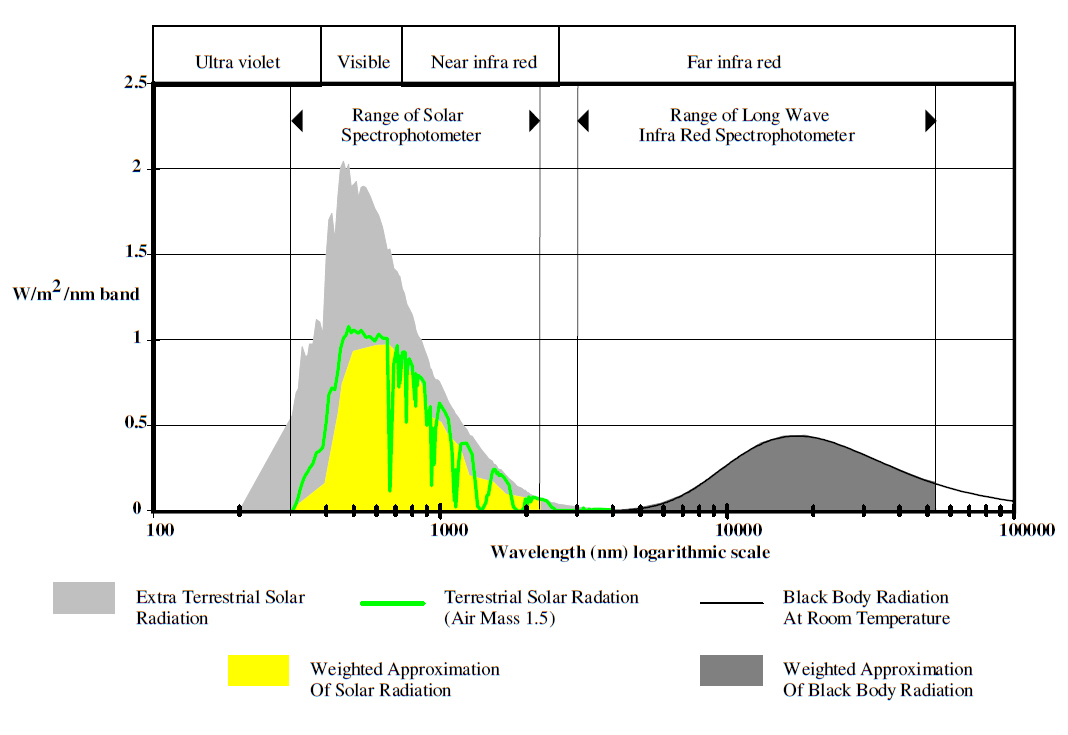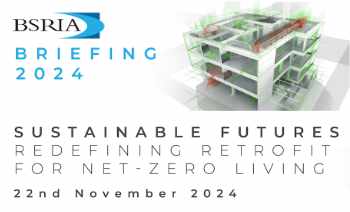Radiation
Contents |
[edit] Introduction
Radiation is a heat transfer mechanism, along with conduction, convection, phase change and mass transfer. All bodies which are hotter than 0°K emit thermal radiation. They also absorb thermal radiation emitted by their surroundings. The difference in the total amount of radiation emitted and absorbed by a body at any given moment may result in a net heat transfer which will produce a change in the temperature of that body.
Thermal radiation includes all those wavelengths of the electromagnetic spectrum which will heat a body when absorbed by it, ranging from about 100nm to 100,000nm. In general, the higher the temperature of a body, the lower the average wavelength of the radiation it emits.
The range of terrestrial temperatures experienced within the built environment is relatively small, and relative to the temperature of the sun this range is ‘cold’ and so radiating at a ‘long’ wavelength compared to the sun. This anomaly allows us to categorise thermal radiation as short-wave solar radiation and terrestrial or long wave infra-red radiation.
[edit] Solar radiation
Solar radiation may be considered to include the ultra violet, visible and near or short wave infra-red wavebands. Around 97% of the solar radiation incident upon the earth's surface is within the range 300 to 2,300nm. Its spectral profile is roughly analogous to that of a black body at 5762°K, and as terrestrial temperatures are unlikely to reach anything like this temperature, solar radiation reaching the earth may be treated as a pure thermal gain.
[edit] Long wave infrared radiation
Most 'terrestrial' radiation occurs within the far or long wave infra-red wavebands. The wavelength of terrestrial radiation varies with temperature, however at room temperature approximately 97% of the radiation emanating from a perfect emitter will be within the range 3,000nm to 50,000nm.
[edit] Nuclear Radiation
Nuclear radiation (also called ionising radiation) is energy released as high-speed charged particles or electromagnetic waves. Radiation can come from many sources, both natural and manufactured. All living things are constantly exposed to low doses of radiation from rocks, sunlight and cosmic rays. There are four major types of radiation: alpha, beta, neutrons, and electromagnetic waves such as gamma rays. There are 3 types of nuclear radiation; Alpha particles, which can only travel short distances and cannot travel through human skin, Beta particles which can penetrate through human skin, but cannot go through your body and Gamma radiation which can go all the way through the human body.
[edit] Greenhouse effect
The difference between long wave infrared radiation and short wave solar radiation produces effects such as the greenhouse effect.
The atmosphere is relatively transparent to solar radiation, this means it allows sunlight to enter the atmosphere and heat the Earth’s surface. These surfaces then re-radiate that heat as long-wave infra-red radiation, which greenhouse gases tend to absorb rather than transmit. The result is that the long-wave infra-red radiation is ‘trapped’ and heat accumulates in the atmosphere causing a warming process.
See greenhouse effect for more information.
[edit] Material properties
The way in which thermal radiation affects different materials is determined by their transmittance, reflectance and absorptance. These properties change for different wavelengths of radiation and for different angles of incidence.
See thermal optical properties for more information.
According to Kirchoff's law the emissivity of a surface is equal to its radiant absorptivity at a given temperature and wavelength.
See emissivity for more information.
[edit] Related articles on Designing Buildings
- Albedo.
- Climate change science.
- Conduction.
- Convection.
- Electromagnetic spectrum.
- Emissivity.
- g-value.
- Heat transfer.
- Low-e glass.
- Phosphorescent building materials.
- Photovoltaics.
- Radiant heating.
- Radiative effect.
- Radiative forcing.
- Shading coefficient.
- Solar gain.
- Solar heat gain coefficient.
- Solar thermal panels.
- Thermal optical properties
- Visible light.
Featured articles and news
Considerate Constructors Scheme acquires Building A Safer Future
Acquisition defines a new era for safety in construction.
AT Awards evening 2024; the winners and finalists
Recognising professionals with outstanding achievements.
Reactions to the Autumn Budget announcement
And key elements of the quoted budget to rebuild Britain.
Chancellor of the Exchequer delivers Budget
Repairing, fixing, rebuilding, protecting and strengthening.
Expectation management in building design
Interest, management, occupant satisfaction and the performance gap.
Connecting conservation research and practice with IHBC
State of the art heritage research & practice and guidance.
Innovative Silica Safety Toolkit
Receives funding boost in memory of construction visionary.
Gentle density and the current context of planning changes
How should designers deliver it now as it appears in NPPF.
Sustainable Futures. Redefining Retrofit for Net Zero Living
More speakers confirmed for BSRIA Briefing 2024.
Making the most of urban land: Brownfield Passports
Policy paper in brief with industry responses welcomed.
The boundaries and networks of the Magonsæte.
London Build Fire and Security Expo
20-21 Nov and now with new Ambassador Programme..
The Scottish Building Safety Levy
Eight weeks of consultation closing on 18 November.
The grey, the brown and the golden rules of housing
shifting policies from the wild west of housing development.
Future proofing homes that are fit for purpose
Specification challenges and the role of plastic.
Thousands of new homes unlocked for brownfield sites
£68 million to 54 councils for neglected land into new homes.
























